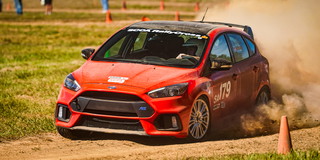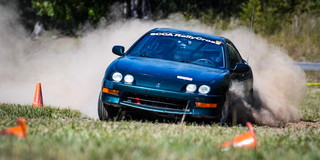
If you are on this website, you’re probably in to driving. And not just any driving, but performance driving. You want to push the limits of both yourself and your machine. And that is the great thing about SCCA, as it provides lots of ways and places to do that. I like to think of SCCA as your one stop shop for all your performance driving needs. From on track to dodging cones to sliding around in the dirt, there is a place for all of us to play! And it’s that last one, sliding around in the dirt, that recently had me flying down the rabbit hole of YouTube videos featuring epic sideways gravel roads and monster air, and then on to the website for DirtFish Rally School.
The idea of doing a rally race has always intrigued me. And I know that if I wanted to pursue that idea, the folks up at DirtFish Rally School would be the best to learn from. So, I started checking out their website and watching some of their videos when I stumbled upon something that got my attention. In one of the videos, they were doing a slalom exercise! And as the Program Manager for SCCA’s Starting Line driving school, where we have a Slalom exercise that we teach as well, this had me intrigued. You don’t see a lot of slaloms in Rally, so I wondered why they would use this element as part of their curriculum, and if the concepts were the same between pavement and dirt. So, we reached out to the DirtFish Instructor from the video to find out! Here is what instructor, Eric Schofhauser had to say:
JH: “You don’t usually see a lot of actual slaloms in rally racing. What is the impetus for including the element as part of your school?”
ES: "While that is true of traditional stage rally, often times the roads can emulate a slalom with a series of short linking corners. Trees, rocks, ditches replace the cones that dictate the line. SCCA style RallyCross will also feature slaloms. So, there is some direct application in that respect. We include the slalom in our curriculum to teach precision and accuracy in the refined control of weight transfer. The slalom is a lot of information and techniques coming at the student quickly. It forces them to learn discrete control of the vehicle inputs and forces them to adapt to the changing conditions within the slalom itself. Much of their future success in our programs relies on their ability to understand how their inputs, vision and weight transfer all blend together in the slalom to create fast yet accurate car control. The focus on the slalom early on helps students develop muscle memory for how to start and stop slides with precise weight transfer, and balance the car using subtle inputs. Going sideways is the easy part, and it certainly looks cool. But the competitor that wins is the one that learns how to be efficient with their inputs and understands how to achieve that precision."
JH: “We teach our students to set a speed before they enter the slalom, and to use all the grip and weight transfer from side to side. We usually refrain from teaching our students to use the brakes, and have them use the throttle only for small adjustments, until they get to the last few cones where we want them to begin to feed into it and accelerate out past the last cone. Does that concept change when you hit the dirt?”
ES: "Completely. The way one does a slalom on tarmac assumes a consistent factor of grip. Because the tires have the sticky surface of tarmac to grip, it allows the driver to rely more heavily on the steering wheel and the stability of staying on the throttle to weave quickly through the slalom. The dirt doesn’t give you the luxury of consistent, reliable grip between the tires and the road. It is still essential to set a certain speed before you enter the slalom. Yet, if a student relies only on the throttle and the smooth steering wheel inputs as they would in a tarmac slalom, they will quickly find themselves getting behind the car and the slalom. This will result in the car having way too much side to side weight transfer--a fish tailing sensation of sorts--leading to the mother of all Scandinavian flicks as the tires lose grip on the loose gravel surface. Many students with autocross or even track driving backgrounds experience this exciting phenomenon when they first try the slalom."
"Because there is naturally minimal lateral grip between the dirt surface and the tires, rally cars like to go in a straight line. So, in the slalom, we are forced to change the line from a shallow curving line into a shallow zig-zag pattern. When one is on throttle constantly, the weight of the car is always over the rear, which makes the front tires float over the loose dirt surface with little usable grip. To get the steering to work and the car to react quickly, we need to move weight onto the front tires. This means that we create a series of small yet precise weight transfers that rotate the car ever so slightly before the cones of the slalom to create straightaways between each one. To achieve this weight transfer, we have to let off of the throttle, which makes the nose of the car dive, pushing the front tires into the dirt. The rear tires lose some grip as the weight moves forward. Now that the weight is forward, we turn the steering wheel to suggest the way the car should go. With the weight of the car forward, the front tires should be digging into the dirt surface, allowing the car to respond to the driver’s input and actually turn. As the speed and confidence increases, so does the need for the brake. Above a certain speed--dirt conditions dependent--the student will need to use the brake after they turn the steering wheel to move even more weight forward, which gives the front tires even more bite to effectively turn the car. This is where the technique of “Lift-Turn-Brake” comes from. Once the car achieves the desired amount of rotation, the steering wheel is straightened, and the throttle is reapplied to move the weight back to the rear. This gives the rear tires grip, pointing the car straight and stopping the slide."
"This all happens rather quickly when actually racing through the slalom. I’m sure it sounds overly complicated. It can be at first. One needs to feel it to truly understand the benefits of this precise weight transfer. To combat the way a car moves around on a loose surface, one must utilize the art of weight transfer that comes from using both pedals and not solely the steering wheel."
So, there we have it! The technique used in a slalom does indeed change slightly when moving from a grippy surface, such as concrete, to loose surfaces like gravel, dirt or snow. But while the techniques may vary, I can say with confidence that the main component to all performance driving stays the same. Whether you are taking a Starting Line School, up in Snoqualmie, Washington participating in a DirtFish Rally School Driving Program, or any of the other great driving schools out there, Eric’s last sentence rings true: The art of weight transfer is a key component to performance driving. And learning to affect that change using both pedals, and not just the steering wheel, is a critical aspect in accomplishing that.
Story by John Hunter
Photo courtesy of DirfFish










